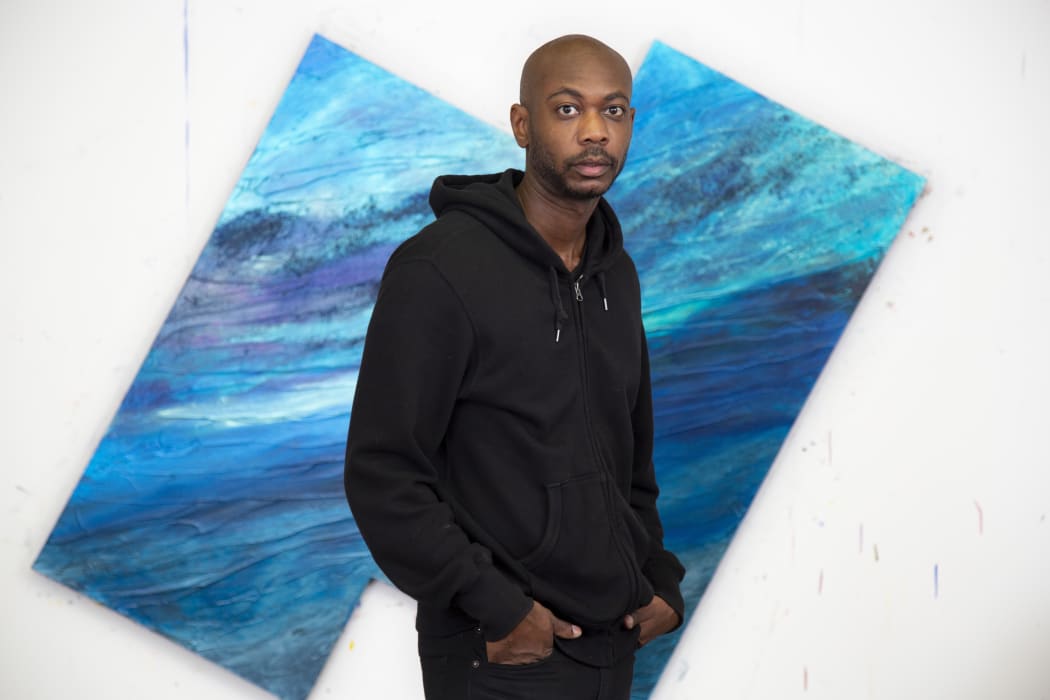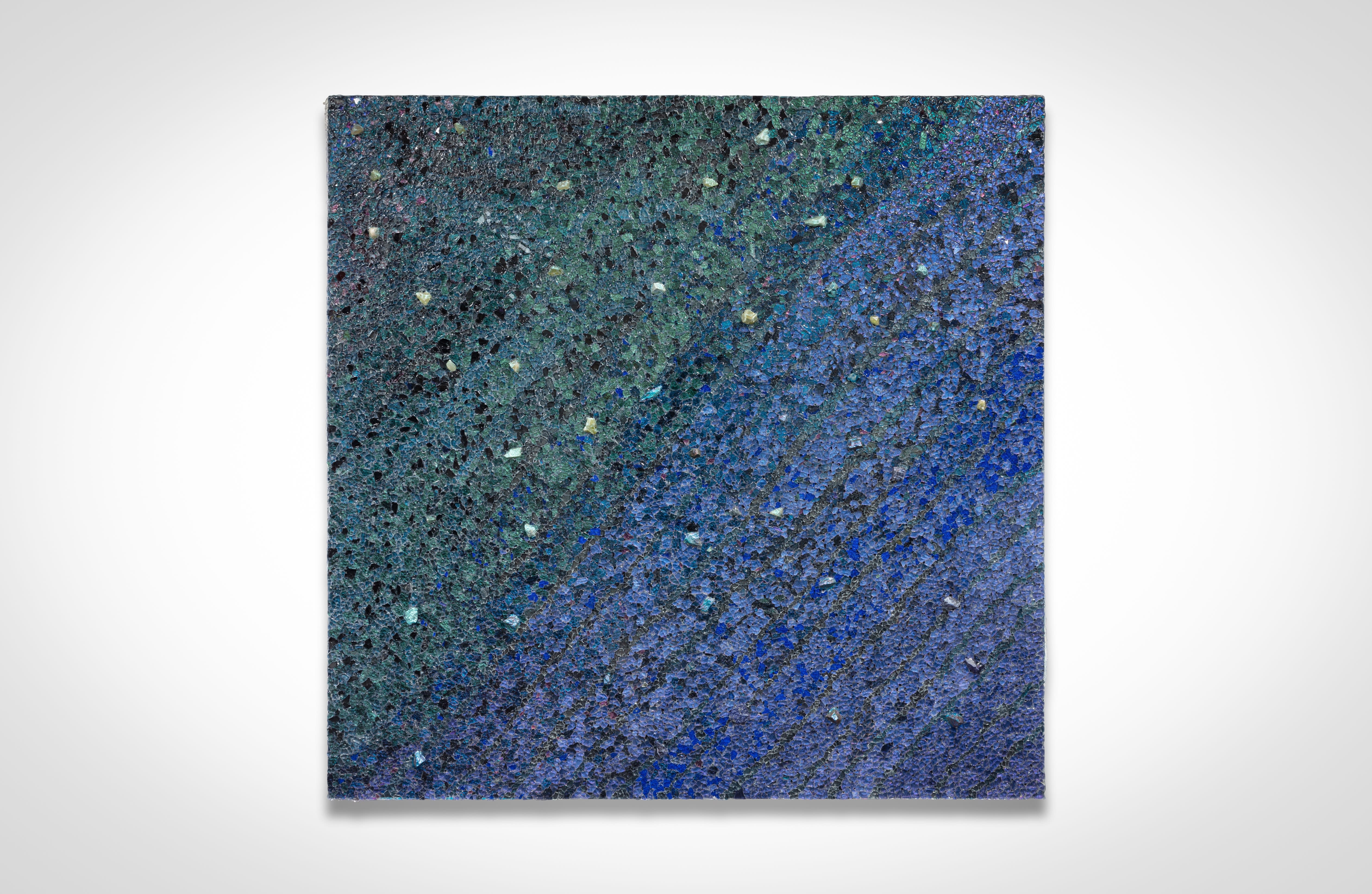
While part of a lineage of artists whose work is deeply invested in exploring color, Alteronce Gumby is interested in examining and redefining its stereotypical associations, which historically have resulted in division and oppression. Through the use of both iridescent pigments and his unique method of sliding glass over a wood panel, Gumby works against this precedent. The two combined result in transparency as well as reflection, causing the viewer to see themselves in the painting while also losing themselves through looking at the painting. As a result, his paintings give place to a bodily encounter. Through this interaction, Gumby seeks to engage the viewer in a visceral fashion in order to bring to light the myriad of ways in which color is related to both race and identity as well as the universality of color. Though abstract, Gumby titles his paintings in order to bring certain relationships to mind. Gumby studied at Hunter College before obtaining his MFA at Yale University. Gumby has held residencies at the Fondation des Etats-Unis, London Summer Intensive, Dumfries House Residency, and Summer Academy in Salzburg Austria, and has been included in numerous solo and group exhibitions worldwide.
In this conversation between Jennifer Earthman and Alteronce Gumby, Gumby describes abstraction’s ability to open up multiple possibilities as well as to result in a pause and a safe space, ever more important in our media-saturated world. He also discusses the broad significance of his materials in addition to race’s impact on his engagement with color: “Color and race are intertwined, and I want to use abstract painting to emancipate all perceptions of color and liberate all aspects of race.”
In a few words, how would you describe abstraction?
In a few words (laughs). I feel like there’s a good [Robert] Motherwell quote where he said that art is like walking down a street and saying look at that? Abstraction for me is to see that thing, rationalize its existence and still not fully understand what it is. And I think the balance between knowing and not knowing is something that abstraction provides for the viewer. It’s a form of thinking and looking at an object, a place, a picture, or a painting and really just seeing the multiple possibilities of it, the openness of it. I feel like abstraction is very much about opening up the interpretation of a certain perspective rather than focusing on one thing. Now abstract painting is something completely different. The term abstraction is one thing and abstract painting means something different. Abstraction is a way of perceiving an idea and abstract painting is a manifestation of abstraction.
What draws you to abstraction? What do you consider to be its relevance in today’s world?
What draws me to abstraction is its ability to use the consciousness to tap into the subconscious and activate the imagination. With abstraction you can’t just look at something and easily unravel it. It's not an advertisement, it’s not trying to sell you something. It's really about you having an experience and having a visceral connection to what you're looking at. There’s so much ambiguity in abstraction. It's a good vehicle that can take you anywhere in your imagination. The movements go from Cubism to Minimalism, Abstract Expressionism to German Expressionism, and everything in between. I want to explore the possibilities of color and beyond. My practice is trying to understand the world through art, and at the same time make a safe space for myself. I think we all need that. I feel like there's so much saturation with images now, especially with social media, you know, it's all about the selfie portraits and Tik Tok dances. I don't think people are really taking time to pause and look inward, as much as they are looking outward onto their mobile phones. So I think abstraction, or abstract art, can allow for that moment of consideration to happen—more of a pause rather than an immediate glance and move on.

Alteronce Gumby. I heard colors, I saw songs, 2021. Acrylic, glass and gemstones on panel, 48 x 48 in (121.9 x 121.9 cm). Image courtesy of the artist and Zeit Contemporary Art, New York
Based on the evolution of abstraction, where would you say your work fits in the arc?
In the evolution of abstraction hopefully I’m right at the top (laughs)! I’m very young and still early in my career. I hope that I'm pushing the genre and the paradigm forward. I really enjoy studying what artists of the past have done and what artists are currently doing. I’m just trying to lead the charge and see how far I can go and to add to the conversation. It's really about creating a lane for myself as an artist. So yeah, we're within the arc and I hope I'm right at the top.
How does your work engage with stereotypical perceptions of color?
My practice of tonal painting started when I noticed how certain colors were defined. Color was just color until it was codified by humans. We use color as signs and signifiers, some for good and some for bad. I wanted to take these stereotypical perceptions of color, and through the use of materials and tonal painting, break down those stereotypes and really expand the definitions and ways in which people see color.
I identify as a Black man and see myself as a complex being, yet the color of my skin is diluted into a single definition. The color black and Black identity are two separate things, but society has congealed them to carry negative associations for people with dark skin. These terms and associations that were put on a color, were put on life. Color and race are intertwined, and I want to use abstract painting to emancipate all perceptions of color and liberate all aspects of race.
You have mentioned a belief in the possibility of achieving universality through color. Are you interested in the creation of universal or timeless messages through the use of color in the vein of Abstract Expressionism?
I think there is a universality in color. I also think color is timeless. Time is man made. The words and definitions we use to describe color is also man made. But the earth and the cosmos aren’t. I use materials like gemstones to reference mineralogy and geology, and time and raw color to reference the cosmos. It's all connected for me. The stars, earth, plants, animals, and humans. Over our evolution, we’ve separated these things and built hierarchies among them. We’ve even used color to separate ourselves based on the color of our skin. It’s really hindering the human race and society. I make tonal paintings to blur the lines on how we see color to bring it back to a sense of universality and unity. I want to change the way people see color. I want them to see each human being as just who they are and not by their skin color.
Does the use of glass factor into your interest in emancipating color from some of its traditional associations?
The use of glass happened as a chance encounter. I saw this material laying in the street on a sunny day, and like the Motherwell quote, I stopped and looked. I was so intrigued by it that I brought some back to my studio. I knew of the Sir Issac Newton experiment with light being depressed through a prism that led to the discovery of the rainbow. I think of the glass as just another ingredient to the recipe. All of the materials I use in my paintings are contributing to the idea of emancipating color, and thinking outside of the box from traditional forms of painting. I’m always thinking about different forms of pigment because color doesn't just come in one form. The use of glass adds a reflective quality to the paintings. So the viewer can kind of see themselves in the painting, and at the same time lose themselves in the experience of looking.

